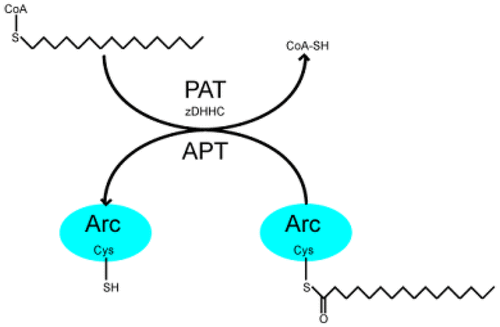当前位置:
X-MOL 学术
›
Biochemistry
›
论文详情
Our official English website, www.x-mol.net, welcomes your feedback! (Note: you will need to create a separate account there.)
Palmitoylation and Membrane Binding of Arc/Arg3.1: A Potential Role in Synaptic Depression
Biochemistry ( IF 2.9 ) Pub Date : 2017-12-26 00:00:00 , DOI: 10.1021/acs.biochem.7b00959 Barbara Barylko , Julia R Wilkerson , Sheridan H Cavalier , Derk D Binns , Nicholas G James 1 , David M Jameson 1 , Kimberly M Huber , Joseph P Albanesi
Biochemistry ( IF 2.9 ) Pub Date : 2017-12-26 00:00:00 , DOI: 10.1021/acs.biochem.7b00959 Barbara Barylko , Julia R Wilkerson , Sheridan H Cavalier , Derk D Binns , Nicholas G James 1 , David M Jameson 1 , Kimberly M Huber , Joseph P Albanesi
Affiliation

|
Activity-regulated cytoskeletal-associated protein (Arc, also known as activity-regulated gene 3.1 or Arg3.1) is induced in neurons in response to salient experience and neural activity and is necessary for activity-induced forms of synaptic plasticity, such as long-term potentiation (LTP) and long-term depression (LTD), cellular substrates of learning and memory. The best-characterized function of Arc is enhancement of the endocytic internalization of AMPA receptors in dendritic spines, a process associated with LTD. Arc has also been implicated in the proteolytic processing of amyloid precursor protein on the surface of endosomes. To mediate these activities, Arc must associate with cellular membranes, but it is unclear whether Arc binds directly to the lipid bilayer or requires protein–protein interactions for membrane recruitment. In this study, we show that Arc associates with pure phospholipid vesicles in vitro and undergoes palmitoylation in neurons, a modification that allows it to insert directly into the hydrophobic core of the bilayer. The palmitoylated cysteines are clustered in a motif, 94CLCRC98, located in the N-terminal half of the protein, which has not yet been structurally characterized. Expression of Arc with three mutated cysteines in that motif cannot support synaptic depression induced by the activity-dependent transcription factor, MEF2 (myocyte enhancer factor 2), in contrast to wild-type Arc. Thus, it appears that palmitoylation regulates at least a subset of Arc functions in synaptic plasticity.
中文翻译:

Arc/Arg3.1 的棕榈酰化和膜结合:在突触抑制中的潜在作用
活动调节细胞骨架相关蛋白(Arc,也称为活动调节基因 3.1 或 Arg3.1)在神经元中被诱导,以响应显着的经验和神经活动,并且对于活动诱导的突触可塑性形式(例如长突触可塑性)是必需的。 - 时程增强(LTP)和长时程抑制(LTD),学习和记忆的细胞基质。Arc 最典型的功能是增强树突棘中 AMPA 受体的内吞内化,这是与 LTD 相关的过程。Arc 还参与了内体表面淀粉样前体蛋白的蛋白水解过程。为了介导这些活动,Arc 必须与细胞膜结合,但尚不清楚 Arc 是直接与脂质双层结合还是需要蛋白质-蛋白质相互作用来进行膜募集。在这项研究中,我们证明 Arc 在体外与纯磷脂囊泡结合,并在神经元中经历棕榈酰化,这种修饰使其能够直接插入双层的疏水核心。棕榈酰化半胱氨酸聚集在位于蛋白质 N 末端一半的基序94 CLCRC 98中,该基序尚未进行结构表征。与野生型 Arc 相比,该基序中具有三个突变半胱氨酸的 Arc 表达不能支持活性依赖性转录因子 MEF2(肌细胞增强因子 2)诱导的突触抑制。因此,棕榈酰化似乎至少调节突触可塑性中 Arc 功能的一个子集。
更新日期:2017-12-26
中文翻译:

Arc/Arg3.1 的棕榈酰化和膜结合:在突触抑制中的潜在作用
活动调节细胞骨架相关蛋白(Arc,也称为活动调节基因 3.1 或 Arg3.1)在神经元中被诱导,以响应显着的经验和神经活动,并且对于活动诱导的突触可塑性形式(例如长突触可塑性)是必需的。 - 时程增强(LTP)和长时程抑制(LTD),学习和记忆的细胞基质。Arc 最典型的功能是增强树突棘中 AMPA 受体的内吞内化,这是与 LTD 相关的过程。Arc 还参与了内体表面淀粉样前体蛋白的蛋白水解过程。为了介导这些活动,Arc 必须与细胞膜结合,但尚不清楚 Arc 是直接与脂质双层结合还是需要蛋白质-蛋白质相互作用来进行膜募集。在这项研究中,我们证明 Arc 在体外与纯磷脂囊泡结合,并在神经元中经历棕榈酰化,这种修饰使其能够直接插入双层的疏水核心。棕榈酰化半胱氨酸聚集在位于蛋白质 N 末端一半的基序94 CLCRC 98中,该基序尚未进行结构表征。与野生型 Arc 相比,该基序中具有三个突变半胱氨酸的 Arc 表达不能支持活性依赖性转录因子 MEF2(肌细胞增强因子 2)诱导的突触抑制。因此,棕榈酰化似乎至少调节突触可塑性中 Arc 功能的一个子集。



























 京公网安备 11010802027423号
京公网安备 11010802027423号